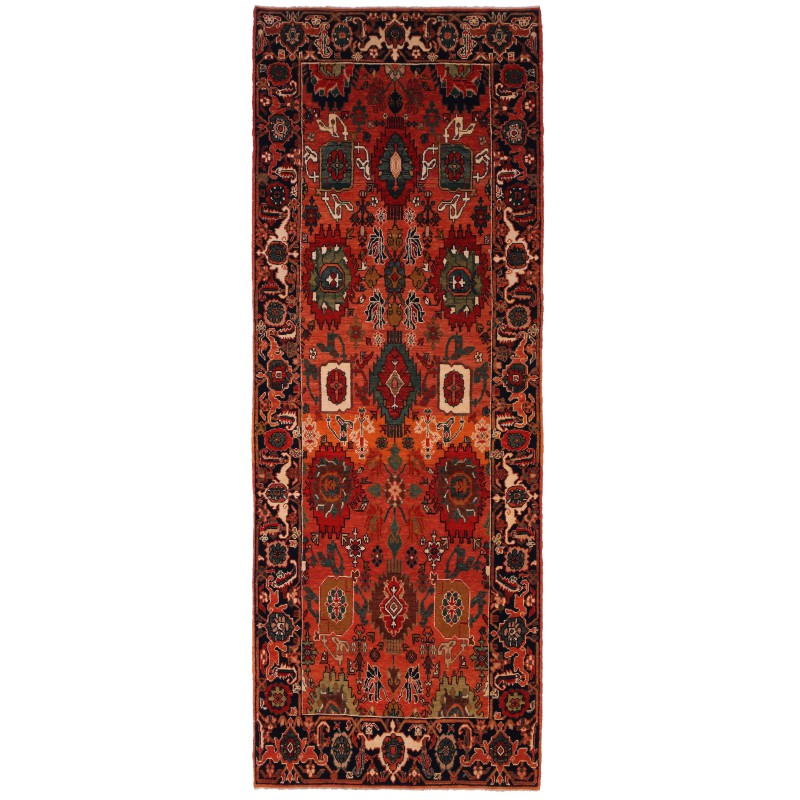
- Stock: 売り切れ
- Model: C50381
- サイズ: 232cm x 84cm
- SKU: ART381
このずれたパターンは、パームレットと花から構成されており、19世紀のビジャール地域、東カルディスタン地域でデザインされたより大きなスキームの一部の印象があります。曲線的な方法で描かれた非常に似たようなパームレットと同じく分かれた葉を組み合わせたものは、ヘラートで17世紀後半から作られた数例のワークショップ絨毯に見られ、同じパターンは18世紀のコーカサスでも使用されました。このデザインは、華やかなカラフルなパームレットと花の繰り返しの複雑な配列を使用しており、それは17世紀の大きな壺技術の絨毯の直系の子孫であることを示しています。
カルディスタンは、デザインと豊かで鮮やかな色彩で優れた絨毯を生み出した地域として通常注目されていませんが、おそらく古くから19世紀まで存在していました。技術的には、19世紀の頑丈で重い二重経糸のビジャールから、このタイプの柔軟な絨毯や非常に繊細な平織りのキリムまでさまざまです。この例に見られるデザインは、明らかに17世紀のモデルに由来しており、その人気が高まり、東ペルシアだけでなくコーカサスにも広がりました。18世紀に至り、19世紀のコーカサスの絨毯でも見ることができます。この絨毯のデザインは、2つの大きな横方向のパームレットに囲まれた小さなパームレットの花の交互の連続で構成され、中央の丸い花のメダリオン、このロゼットに向かって両方の異なるデザインの4つの大きなパームレット形状、およびロゼットで満たされた4つのダイヤモンド形のカルトゥーシュが対角軸上に配置されています。小さなスケールの格子システムが、フィールドの背景のほとんどを補完的なパターンとして埋めています。ボーダーデザインは、カルトゥーシュと星のメダリオンの連続の確立された伝統に従っています。両方のガードストライプは、活発な角型の葉の巻きスクロールで埋められています。格子は無限に続いているように見えます - まるで特徴的なビジャールのフレームに囲まれたセクションが見えるかのようです。絨毯のデザインは、私たちのデザイナーによって解釈され、鮮やかな色彩がこの絨毯に選ばれています。
This offset pattern is composed of palmettes and flowers, one has the impression that it is only part of a larger scheme designed 19th-century rug from the Bidjar region, Eastern Kurdistan area. Very similar palmettes, drawn in a curvilinear manner and combined with identical forked leaves, can be seen on a few examples of workshop carpets made from the late seventeenth century onward in Herat in Khurasan province, east Persia, and the same pattern known as Harshang design was used in the Caucasus in the eighteenth century, as well. The design employs floral, richly complex repeating arrays of brilliant color palmettes and flowers that mark it as a lineal descendant of the great vase-technique carpets of the seventeenth century.
全部で11色使っています。主な4色は以下です。
- Congo Pink 306 (茜)
- Midnight Blue 347 (トウダイグサ - 茜 - 藍)
- Natural Wool Color 320 (羊そのままの色)
- Emerald Green 407 (カモミール - 藍)
上の番号は私たちのカラーコードです。()の中は、主な草木染めの材料です。
